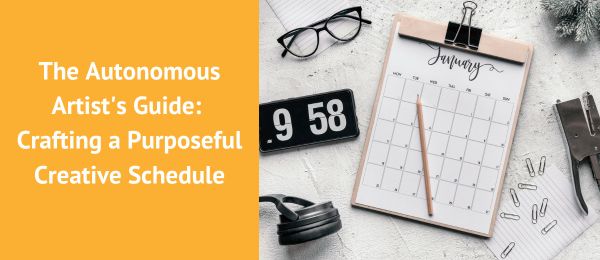For the autonomous artist or designer, the boundless freedom to create is a double-edged sword. While autonomy allows for unbridled expression, the absence of structure can lead to creative drift, discouragement, and the allure of shiny new projects. In a world where no one holds them accountable, the need for a purposeful creative schedule becomes paramount. This article aims to provide a step-by-step guide for individual artists and designers, empowering them to stay on track, motivated, and focused:
The Challenge of Autonomy: Autonomous creators often find themselves at the crossroads of limitless possibilities and the struggle to maintain discipline. The lack of external accountability can result in aimless wandering, leading to creative blocks and the temptation to abandon projects in search of the next captivating idea. Crafting a creative schedule tailored to an individual’s unique rhythm and preferences is essential for maintaining focus and purpose.
Step-by-Step Creative Schedule:
1. Define Your Purpose:
- Clarify your artistic goals and objectives.
- Identify the overarching purpose of your creative endeavours.
2. Weekly Goal Setting:
- Break down your larger goals into manageable weekly targets.
- Establish clear, achievable objectives for each week.
3. Time Blocking:
- Allocate specific time blocks for different aspects of your creative process.
- Include time for ideation, sketching, feedback, and refinement.
4. Morning Rituals:
- Create a morning routine that sets a positive tone for the day.
- Incorporate activities that inspire and energize you.
5. Accountability Tools:
- Incorporate OPIC System to your art and design practice.
- Utilize apps or tools that track your progress.
- Set reminders for goal checkpoints and deadlines.
6. Variety Within Structure:
- Incorporate variety within your schedule to prevent monotony.
- Alternate between different projects and creative tasks.
7. Review and Adjust:
- Regularly assess your progress and celebrate achievements.
- Adjust your schedule based on what works best for you.
8. Creative Breaks: Refesh!
- Integrate intentional breaks to avoid burnout.
- Use breaks for activities that recharge your creativity.
9. Connect with Peers:
- Foster connections with fellow artists or designers.
- Seek feedback and share experiences for mutual inspiration.
10. Embrace Challenges:
- View challenges as opportunities for growth.
- Embrace the discomfort of pushing creative boundaries.
Motivation and Purpose: The key to sticking to a creative schedule lies in infusing it with motivation and purpose. By defining clear goals, breaking them down into manageable tasks, and establishing routines that inspire, an autonomous artist can maintain focus and direction. The schedule serves as a compass, guiding the creative journey with purpose, ensuring that every stroke, pixel, or idea aligns with the overarching vision. It’s a commitment to the craft, a testament to the artist’s dedication, and a roadmap to transforming creative autonomy into meaningful, purposeful output.
Want to learn more?
- Find out more
- Launch Pad + Accelerator Expressions of Interest
- Selling and Licensing Your Art & Designs Around the World with ArtSHINE.
We’re here to help you to take action, just like we’ve helped thousands of other entrepreneurs, business owners, and creative professionals all around the globe.
Now is the time to let your passion SHINE.
Now is the time to Make Tomorrow Today!
To your success, Vinh Van Lam and Stuart Horrex Cofounders
ArtSHINE.com





